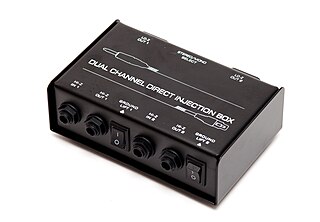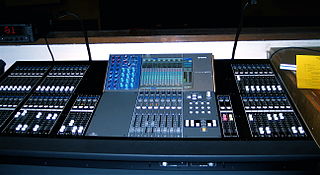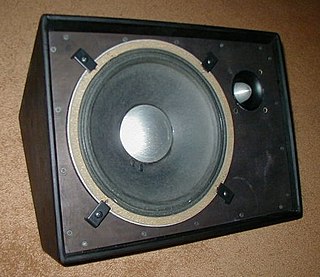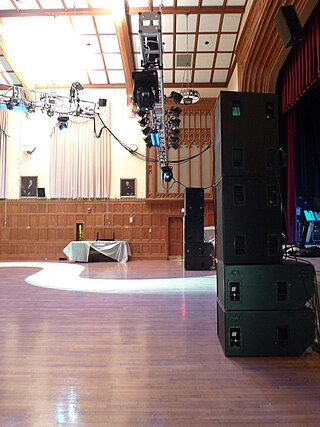
A mixing console or mixing desk is an electronic device for mixing audio signals, used in sound recording and reproduction and sound reinforcement systems. Inputs to the console include microphones, signals from electric or electronic instruments, or recorded sounds. Mixers may control analog or digital signals. The modified signals are summed to produce the combined output signals, which can then be broadcast, amplified through a sound reinforcement system or recorded.

A DI unit is an electronic device typically used in recording studios and in sound reinforcement systems to connect a high-output impedance, line level, unbalanced output signal to a low-impedance, microphone level, balanced input, usually via an XLR connector and XLR cable. DIs are frequently used to connect an electric guitar or electric bass to a mixing console's microphone input jack. The DI performs level matching, balancing, and either active buffering or passive impedance matching/impedance bridging to minimize unwanted noise, distortion, and ground loops. DI units are typically metal boxes with input and output jacks and, for more expensive units, “ground lift” and attenuator switches.

A digital audio workstation (DAW) is an electronic device or application software used for recording, editing and producing audio files. DAWs come in a wide variety of configurations from a single software program on a laptop, to an integrated stand-alone unit, all the way to a highly complex configuration of numerous components controlled by a central computer. Regardless of configuration, modern DAWs have a central interface that allows the user to alter and mix multiple recordings and tracks into a final produced piece.

A sound reinforcement system is the combination of microphones, signal processors, amplifiers, and loudspeakers in enclosures all controlled by a mixing console that makes live or pre-recorded sounds louder and may also distribute those sounds to a larger or more distant audience. In many situations, a sound reinforcement system is also used to enhance or alter the sound of the sources on the stage, typically by using electronic effects, such as reverb, as opposed to simply amplifying the sources unaltered.

A vision mixer is a device used to select between several different live video sources and, in some cases, compositing live video sources together to create visual effects.

An aux-send is an electronic signal-routing output used on multi-channel sound mixing consoles used in recording and broadcasting settings and on PA system amplifier-mixers used in music concerts. The signal from the auxiliary send is often routed through outboard audio processing effects units and then returned to the mixer using an auxiliary return input jack, thus creating an effects loop. This allows effects to be added to an audio source or channel within the mixing console. Another common use of the aux send mix is to create monitor mixes for the onstage performers' monitor speakers or in-ear monitors. The aux send's monitor mix is usually different from the front of house mix the audience is hearing.

A DJ mixer is a type of audio mixing console used by disc jockeys (DJs) to control and manipulate multiple audio signals. Some DJs use the mixer to make seamless transitions from one song to another when they are playing records at a dance club. Hip hop DJs and turntablists use the DJ mixer to play record players like a musical instrument and create new sounds. DJs in the disco, house music, electronic dance music and other dance-oriented genres use the mixer to make smooth transitions between different sound recordings as they are playing. The sources are typically record turntables, compact cassettes, CDJs, or DJ software on a laptop. DJ mixers allow the DJ to use headphones to preview the next song before playing it to the audience. Most low- to mid-priced DJ mixers can only accommodate two turntables or CD players, but some mixers can accommodate up to four turntables or CD players. DJs and turntablists in hip hop music and nu metal use DJ mixers to create beats, loops and so-called scratching sound effects.
In audio processing and sound reinforcement, an insert is an access point built into the mixing console, allowing the audio engineer to add external line level devices into the signal flow between the microphone preamplifier and the mix bus.
A channel strip is a device that allows the output of an audio device to be amplified to a line level and integrated into some other system. An audio channel strip may be a stand-alone unit or one of many units built into a mixing desk. It usually includes a microphone preamp with a switchable phantom power voltage to power condenser microphones and some form of audio equalization. Some designs also offer other facilities including audio compression, de-essing, noise-gating and limiting.

The Yamaha M7CL is a digital mixer that was manufactured by Yamaha Pro Audio. Two models with onboard analog input exist: the M7CL-32 and M7CL-48. These models have 40 - and 56 -input channels respectively, counting mono channels. Mixes, masters, groups, DCAs and individual channels can then be routed to an output via any number of the board's 16 configurable output XLR ports. The eight faders of the master control section can control multiple functions by way of "layers" in the same manner as the Yamaha PM5D. The board features Yamaha's "Selected Channel" technology, and Centralogic, unique to the M7CL. It can be augmented with more inputs or outputs via expansion cards, and can be fitted with third-party cards such as ones made by Aviom (A-Net), AuviTran (EtherSound), Audinate, AudioService (MADI), Dan Dugan (automixer), Riedel Communications (RockNet), Waves Audio, and Optocore. The M7CL-48ES recently joined the line-up with built-in EtherSound for digital networking using EtherSound stage boxes.

Live sound mixing is the blending of multiple sound sources by an audio engineer using a mixing console or software. Sounds that are mixed include those from instruments and voices which are picked up by microphones and pre-recorded material, such as songs on CD or a digital audio player. Individual sources are typically equalised to adjust the bass and treble response and routed to effect processors to ultimately be amplified and reproduced via a loudspeaker system. The live sound engineer listens and balances the various audio sources in a way that best suits the needs of the event.
Yamaha Pro Audio, Inc. is a division of the Yamaha Corporation that offers a complete line of beginner professional audio products for the live sound and sound reinforcement markets. It has a long history of introducing significant products for the professional audio market such as the PM-1000 modular mixing console, the REV1 and SPX90 digital signal processors, and the 01, 02R, 03D, PM1D, PM5D, QL5, M7CL, CL5, and PM10/7 Rivage digital mixing consoles.

A stage monitor system is a set of performer-facing loudspeakers called monitor speakers, stage monitors, floor monitors, wedges, or foldbacks on stage during live music performances in which a sound reinforcement system is used to amplify a performance for the audience. The monitor system allows musicians to hear themselves and fellow band members clearly.

In sound recording and reproduction, audio mixing is the process of optimizing and combining multitrack recordings into a final mono, stereo or surround sound product. In the process of combining the separate tracks, their relative levels are adjusted and balanced and various processes such as equalization and compression are commonly applied to individual tracks, groups of tracks, and the overall mix. In stereo and surround sound mixing, the placement of the tracks within the stereo field are adjusted and balanced. Audio mixing techniques and approaches vary widely and have a significant influence on the final product.
Musical outboard equipment or outboard gear is used to process or alter a sound signal separately from functionality provided within a mixing console or a digital audio workstation. Outboard effects units can be used either during a live performance or in the recording studio.
A mixing engineer is responsible for combining ("mixing") different sonic elements of an auditory piece into a complete rendition, whether in music, film, or any other content of auditory nature. The finished piece, recorded or live, must achieve a good balance of properties, such as volume, pan positioning, and other effects, while resolving any arising frequency conflicts from various sound sources. These sound sources can comprise the different musical instruments or vocals in a band or orchestra, dialogue or foley in a film, and more.
A sound card mixer is the analog part of a sound card that routes and mixes sound signals. This circuit receives inputs from both external connectors and the sound card's digital-to-analog converters. It selects or mutes, amplifies these signals, adds them together, and finally routes the result to both external output connectors and the sound card's analog-to-digital converters. Different mixing schemes are in use, but the ones implemented in most IBM-PC compatible computers today are variants of a scheme defined in Intel's AC'97 Audio Component Specification.

A matrix mixer is an audio electronics device that routes multiple input audio signals to multiple outputs. It usually employs level controls such as potentiometers to determine how much of each input is going to each output, and it can incorporate simple on/off assignment buttons. The number of individual controls is at least the number of inputs multiplied by the number of outputs.

A professional audio store is a retail business that sells, and in many cases rents, sound reinforcement system equipment and PA system components used in music concerts, live shows, dance parties and speaking events. This equipment typically includes microphones, power amplifiers, electronic effects units, speaker enclosures, monitor speakers, subwoofers and audio consoles (mixers). Some professional audio stores also sell sound recording equipment, DJ equipment, lighting equipment used in nightclubs and concerts and video equipment used in events, such as video projectors and screens. Some professional audio stores rent "backline" equipment used in rock and pop shows, such as stage pianos and bass amplifiers. While professional audio stores typically focus on selling new merchandise, some stores also sell used equipment, which is often the equipment that the company has previously rented out for shows and events.

An audio interface is a piece of computer hardware that allows the input and output of audio signals to and from a host computer or recording device.
















